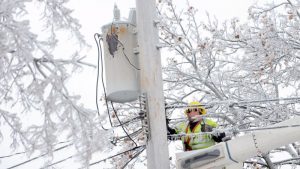
A new report from the North American Electric Reliability Corporation (NERC) predicts a large part of the North American region is at risk of “insufficient electricity supplies” during peak winter conditions this year.
In a report to regulators across the country, including those in Oklahoma, NERC declared, ” Prolonged, wide-area cold snaps threaten the reliable performance of BPS generation and the availability of fuel supplies for natural-gas-fired generation.”
The prediction in NERC’s 2023-2024 Winter Reliability Assessment also covered Oklahoma and other states that fall under the Southwest Power Pool where it noted that the Anticipated Reserve Margin of 38.8% is over 30 percentage points lower than last winter, a decline driven by higher forecasted peak demand and less resource capacity.
“While the reserve margin is adequate for normal forecasted
peak demand and expected generator outages, higher demand levels and outages that have occurred during extreme cold weather result in shortfalls that can trigger energy emergencies,” explained NERC.
“The vast wind resources in the area can alleviate firm capacity shortages under the right conditions; however, energy risks emerge during periods of low wind or forecast uncertainty and high electricity demand.”
NERC expressed more concerns about the northern part of the U.S. and Canada where in recent years, such as the 2021 Winter Storm Uri, more than 20% of generating capacity was forced off-line when freezing temperatures extended over parts of the country that are not typically exposed to such conditions.

The Southwest Power Pool covers 546,000 square miles in all or parts of Arkansas Iowa, Kansas, Louisiana, Minnesota, Missouri, Montana, Nebraska, New Mexico, North Dakota, Oklahoma, South Dakota, Texas, and Wyoming. It involves 61,000 miles of transmission linles, 756 generating plants and 4,811 transmission-class substations that serve a population of more than 18 million people.
• SPP anticipates that planning reserves are adequate for the upcoming winter season. Reserve margins have fallen this winter because of increased peak demand projections and declining anticipated resources.
• SPP does not anticipate any emerging reliability issues impacting the area for the 2023–2024 winter season but realizes that interruptions to fuel supply could create unique operation challenges.
• SPP continues to work with neighboring areas to address potential electricity deliverability issues associated with extreme weather events. Efforts are aimed at enhancing
communications and operator preparedness.
• To minimize conservative operations, EEAs, and the response to mid-range forecast error uncertainty in wind forecasts, SPP created some new mitigation processes to deal with high-impact areas of concern. SPP has developed operational mitigation teams, processes, and procedures that have been put in place to maintain real-time reliability needs.
• SPP created a Resource and Energy Adequacy Leadership Team that is addressing numerous resource adequacy initiatives that are addressing an expected unserved energy (EUE) standard, fuel assurance, winter requirements, winter PRM, outage policies, demand response, accreditation, and other areas of impact.
The Southwest Power Pool contends its existing resources will meet operating reserve requirements under normal peak-demand scenarios. However, during extreme cold winter weather and storms might be another matter.
” Above-normal winter peak load and outage conditions could result in the need to employ operating mitigations (i.e., demand response and transfers) and EEAs. Load shedding is unlikely but may be needed under wide-area cold weather events,” according to ther report.



